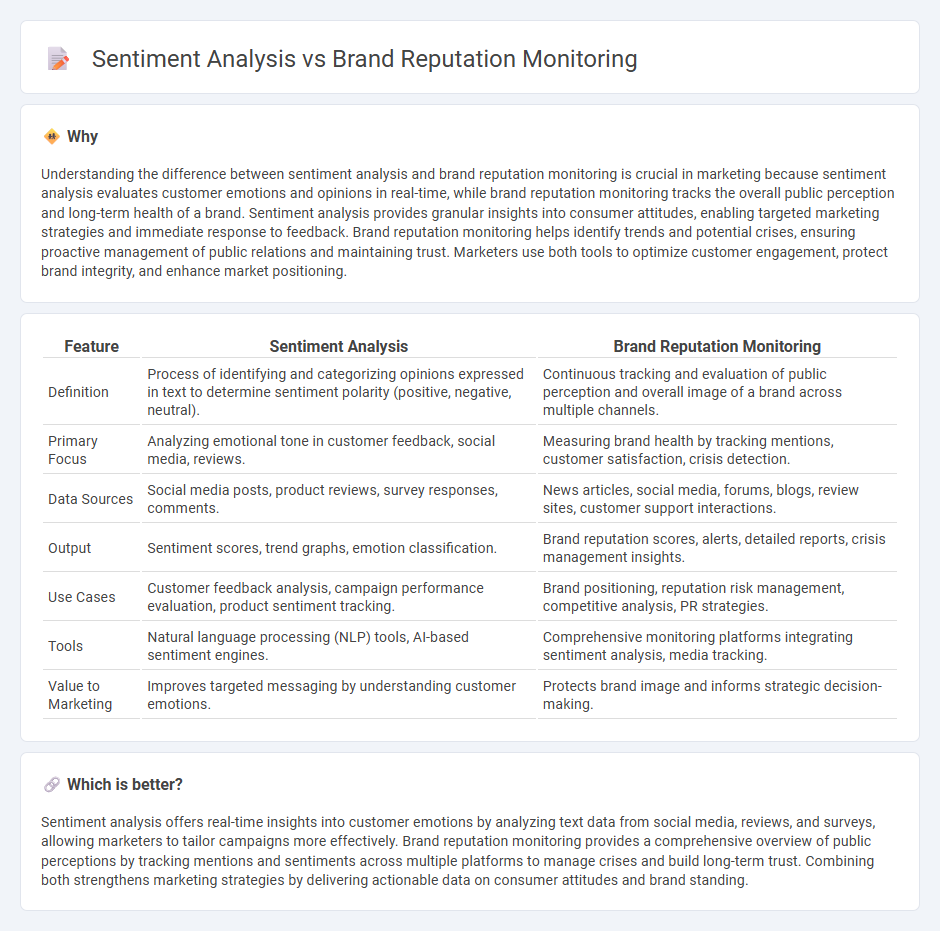
Sentiment analysis utilizes natural language processing to identify and quantify emotions in customer feedback, enabling marketers to understand public perception at scale. Brand reputation monitoring continuously tracks online mentions across social media, review sites, and news outlets to manage and protect a company's image proactively. Discover how integrating these strategies can amplify your marketing effectiveness and drive informed decision-making.
Why it is important
Understanding the difference between sentiment analysis and brand reputation monitoring is crucial in marketing because sentiment analysis evaluates customer emotions and opinions in real-time, while brand reputation monitoring tracks the overall public perception and long-term health of a brand. Sentiment analysis provides granular insights into consumer attitudes, enabling targeted marketing strategies and immediate response to feedback. Brand reputation monitoring helps identify trends and potential crises, ensuring proactive management of public relations and maintaining trust. Marketers use both tools to optimize customer engagement, protect brand integrity, and enhance market positioning.
Comparison Table
| Feature | Sentiment Analysis | Brand Reputation Monitoring |
|---|---|---|
| Definition | Process of identifying and categorizing opinions expressed in text to determine sentiment polarity (positive, negative, neutral). | Continuous tracking and evaluation of public perception and overall image of a brand across multiple channels. |
| Primary Focus | Analyzing emotional tone in customer feedback, social media, reviews. | Measuring brand health by tracking mentions, customer satisfaction, crisis detection. |
| Data Sources | Social media posts, product reviews, survey responses, comments. | News articles, social media, forums, blogs, review sites, customer support interactions. |
| Output | Sentiment scores, trend graphs, emotion classification. | Brand reputation scores, alerts, detailed reports, crisis management insights. |
| Use Cases | Customer feedback analysis, campaign performance evaluation, product sentiment tracking. | Brand positioning, reputation risk management, competitive analysis, PR strategies. |
| Tools | Natural language processing (NLP) tools, AI-based sentiment engines. | Comprehensive monitoring platforms integrating sentiment analysis, media tracking. |
| Value to Marketing | Improves targeted messaging by understanding customer emotions. | Protects brand image and informs strategic decision-making. |
Which is better?
Sentiment analysis offers real-time insights into customer emotions by analyzing text data from social media, reviews, and surveys, allowing marketers to tailor campaigns more effectively. Brand reputation monitoring provides a comprehensive overview of public perceptions by tracking mentions and sentiments across multiple platforms to manage crises and build long-term trust. Combining both strengthens marketing strategies by delivering actionable data on consumer attitudes and brand standing.
Connection
Sentiment analysis uses natural language processing to evaluate customer opinions, providing real-time insights into public perception of a brand. Brand reputation monitoring leverages these insights to detect emerging issues, track sentiment trends, and manage customer feedback across social media and review platforms. Together, they enable marketers to respond proactively, enhance brand loyalty, and optimize marketing strategies based on data-driven sentiment signals.
Key Terms
**Brand Reputation Monitoring:**
Brand reputation monitoring involves continuously tracking and analyzing mentions, reviews, and feedback across various channels to assess the overall perception of a brand. It leverages tools like social listening platforms, online review analysis, and media monitoring to identify potential risks and opportunities in real-time. Discover how brand reputation monitoring can protect and enhance your company's image.
Brand Mentions
Brand reputation monitoring captures all brand mentions across various channels, providing a comprehensive view of public perception and potential risks. Sentiment analysis evaluates these mentions to determine whether the expressed opinions are positive, negative, or neutral, enabling targeted reputation management strategies. Discover how combining these tools can enhance your brand's market position and customer trust.
Crisis Management
Brand reputation monitoring tracks real-time mentions and media coverage to identify potential PR crises before they escalate, while sentiment analysis evaluates the emotional tone of customer feedback to gauge public perception during critical events. Effective crisis management integrates both tools to promptly detect negative spikes and understand audience sentiment, enabling strategic communication responses that mitigate damage. Explore detailed strategies on leveraging brand reputation monitoring and sentiment analysis for proactive crisis management.
Source and External Links
Online Reputation Monitoring Tools - Cision - Brand reputation monitoring involves tracking metrics such as volume of online mentions, sentiment analysis, engagement, influence score, and review scores to assess and manage public perception effectively using robust data and KPIs.
6 Expert Tips to Master Brand Reputation Management | Brand24 - Brand reputation monitoring requires constant tracking of online conversations, brand mentions, and reputation scores to control how people perceive a brand and respond promptly to both positive and negative feedback.
Top 13 Online Reputation Monitoring Software (2025) - Meltwater - Effective brand reputation monitoring is supported by tools like Meltwater and Mention, which offer real-time tracking, sentiment analysis, alerts for spikes in conversations, and comprehensive coverage across many digital platforms to help manage and protect brand image.
 dowidth.com
dowidth.com